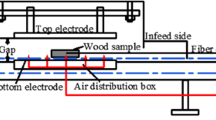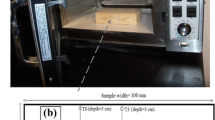Abstract
Radio-frequency (RF) and microwave (MW) heating for phytosanitary treatment of green wood in compliance with international standards for phytosanitary measures no. 15 (ISPM-15) were evaluated and compared to assess treatment time, depth of electromagnetic wave (EMW) penetration and heating uniformity. White oak (Quercus alba) cants (48 cm long with cross-section dimensions ranging from 10 × 10 cm2 to 25 × 25 cm2) were heated in a 19 MHz RF or 2.45 GHz MW laboratory oven using an equivalent heating power (3.4 kW). In each specimen, temperature was measured at different depths (distance from the upper face). Specimens were held in the treatment chamber for 2 min after the target temperature of 60 °C was achieved through the profile of the specimen to ensure compliance with the ISPM-15 treatment schedule. Thermal image analyses of treated specimens as well as theoretical depth of penetration for dielectric energy were explored. Wood specimens were also heated using RF at high power (9–11 kW) and results were compared with RF heating at 3.4 kW. For wood with cross-section dimensions of 10 × 10 cm2 to 15 × 15 cm2, heating rates for RF and MW were relatively similar. However, above 15 × 15 cm2, RF heating was more than 40 % faster with greater heating uniformity than MW. The theoretical values derived for depth of penetration and thermal image analyses indicate that RF (19 MHz) penetrates wood more uniformly and is better suited than MW (2.45 GHz) for bulk volume treatments of wood.







Similar content being viewed by others
Abbreviations
- DH:
-
Dielectric heating
- dp :
-
Depth of EMW Penetration
- EMF:
-
Electro-magnetic field
- EMW:
-
Electro-magnetic wave
- EPRF:
-
Equivalent power radio frequency
- HPRF:
-
High power radio-frequency
- ISPM:
-
International standards for phytosanitary measures
- MW:
-
Micro-wave
- RF:
-
Radio-frequency
- t60 :
-
Treatment time when all temperature probes used in a DH trial recorded minimum 60 °C
- WPM:
-
Wood packaging materials
References
Andreuccetti D, Bini M, Ignesti A, Gambetta A, Olmi R (1994) Microwave destruction of woodworms. J Microw Power Electromagn Energy 29(3):153–160
Anil SK (2010) Environmental analysis of pallets using life-cycle analysis and multi-objective dynamic programming. The Pennsylvania State University. Master’s Thesis
ASTM-D4442 (2007) Standard test methods for direct moisture content measurement of wood and wood-base materials. ASTM International, West Conshohocken
Brockerhoff E, Haack RA (2011) ISPM No. 15 and the incidence of wood pests : recent findings, policy changes, and current knowledge gaps. In: Every country worldwide is dealing with exotic pests. International Research Group on Wood Protection, IRG 42, Queenstown, New Zealand
Bush RJ, Araman PA (2009) Material use and production changes in the US Wood pallet and container industry: 1992 to 2006. In: Pallet Enterp. http://www.palletenterprise.com/articledatabase/view.asp?articleID=2866. Accessed 2 Apr 2014
FAO (2011) Guide to implementation of phytosanitary standards in forestry—FAO Forestry paper 164. Food and Agriculture Organization of the United Nations, Rome
FAO (2013) ISPM-15: Regulation of wood packaging material in international trade. Food and Agriculture Organization of the United Nations, International Plant Protection Convention (IPPC), Rome, pp 1–20
FAO (2014) A quick guide on dielectric heating as a phytosanitary treatment for wood packaging material. Food and Agriculture Organization of the United Nations, International Plant Protection Convention (IPPC), Rome (ENG No. 04)
FCEC (2012) Quantification of the economic, environmental and social impacts of introducing mandatory treatment requirements for wood packaging material circulating inside the European Union. In: Food Chain Evaluation Consortium (FCEC), Directorate General for Health and Consumers Quantification, EU, Berlin
Gao M, Tang J, Johnson JA, Wang S (2012) Dielectric properties of ground almond shells in the development of radio frequency and microwave pasteurization. J Food Eng 112:282–287
Guan D, Tang J, Awuah G (2015) Temperature measurement in radio-frequency applications. Radio-frequency heating in food processing principles and applications. CRC Press, Boca Raton, pp 31–39
Hassan HF, Tola Y, Ramaswamy HS (2015) Radio-frequency and microwave applications: similarities, advantages and limitations. Radio-frequency heating in food processing principles and applications. CRC Press, Boca Raton, pp 21–28
Henin J-M, Charron S, Luypaert PJ, Jourez B, Hébert J (2008) Strategy to control the effectiveness of microwave treatment of wood in the framework of the implementation of ISPM 15. For Prod J 58(12):75–81
Henin J-M, Leyman M, Bauduin A, Jourez B, Hébert J (2014) Phytosanitary treatment of European pallets by microwave: developing a program to ensure compliance with ISPM 15 and monitoring its efficacy on the house longhorn beetle (Hylotrupes bajulus L.). Eur J Wood Wood Prod 72:623–633
James WL (1975) Dielectric properties of wood and hardboard. Variation with temperature, frequency, moisture content and grain direction. USDA For Serv Res Pap FPL 245:1–32
Jiao S (2012) Development of non-chemical postharvest treatments for disinfecting agricultural products-PhD Thesis. Washington State University
Jiao S, Luan D, Tang J (2015) Principles of radiofrequency and microwave heating. Radio-frequency heating in food processing principles and applications. CRC Press, Boca Raton, pp 1–19
Koubaa A, Perré P, Hutcheon RM, Lessard J (2008) Complex dielectric properties of the sapwood of aspen, white birch, yellow birch, and sugar maple. Dry Technol 26:568–578
Laborelec CJ (2011) Application note on dielectric heating. In: European Copper Institute. www.leonardo-energy.org/drupal/node/1845. Accessed 4 May 2014
Lazarescu C, Dale A, Uzunovic A, Breuil C, Stavros A (2010) Radio frequency heating pasteurization of pine wood nematode (Bursaphelenchus xylophilus) infected wood. Eur J Wood Wood Prod 69:573–578
Mehdizadeh M (1994) Engineering and scale-up considerations for microwave-induced reactions. Res Chem Intermed 20:79–84
Mehdizadeh M (2010) Microwave/RF applicators and probes for material heating, sensing, and plasma generation: a design guide. Elsevier, San Diego
Mermelstein NH (1997) Interest in radiofrequency heating heats up. Food Technol 51:794–795
Nelson SO (1967) Electromagnetic energy. In: Kilgore W, Doutt R (eds) Pest Control Biological, Physical and Selected Chemical Methods. Academic Press, New York, pp 89–145
Olmi R, Bini M, Ignesti C, Riminesi C (2000) Dielectric properties of wood from 2 to 3 GHz. J Microw Power Electromagn Energy 35:135–143
Strutt A, Turner JA, Garrett L, Haack RA, Olson L (2013) Evaluating the impacts of an international phytosanitory standard for wood packaging material: global and United States implications. For Policy Econ 27:54–64
UNEP (2000) The montreal protocol on the substances that deplete the ozone layer. UNEP, Nairobi
Uzunovic A, Gething B, Coelho A, Dale A, Janowiak J, Mack R, Hoover K (2012) Lethal temperature for pinewood nematode, Bursaphelenchus xylophilus, in infested wood using radio frequency (RF) energy. J Wood Sci 59:160–170
Wang S, Tang J, Johnson JA, Mitcham E, Hansen JD, Hallman G, Drake SR, Wang Y (2003) Dielectric properties of fruits and insect pests as related to radio frequency and microwave treatments. Biosyst Eng 85:201–212
Wang Y, Li Y, Wang S, Zhang L, Gao M, Tang J (2011) Review of dielectric drying of foods and agricultural products. Int J Agric Biol Eng 4:1–19
Acknowledgments
We thank Ben Wilson of PSC, Inc. for providing technical support for the RF oven, Glenn Blaker for his electrode modeling contributions, and Michael Powell for assistance with securing experimental materials. This study was supported from funding provided by the USDA-Methyl Bromide Transitions Program to Kelli Hoover and John Janowiak (Grant 2012-51102-20208).
Author information
Authors and Affiliations
Corresponding author
Rights and permissions
About this article
Cite this article
Dubey, M.K., Janowiak, J., Mack, R. et al. Comparative study of radio-frequency and microwave heating for phytosanitary treatment of wood. Eur. J. Wood Prod. 74, 491–500 (2016). https://doi.org/10.1007/s00107-016-1025-2
Received:
Published:
Issue Date:
DOI: https://doi.org/10.1007/s00107-016-1025-2




